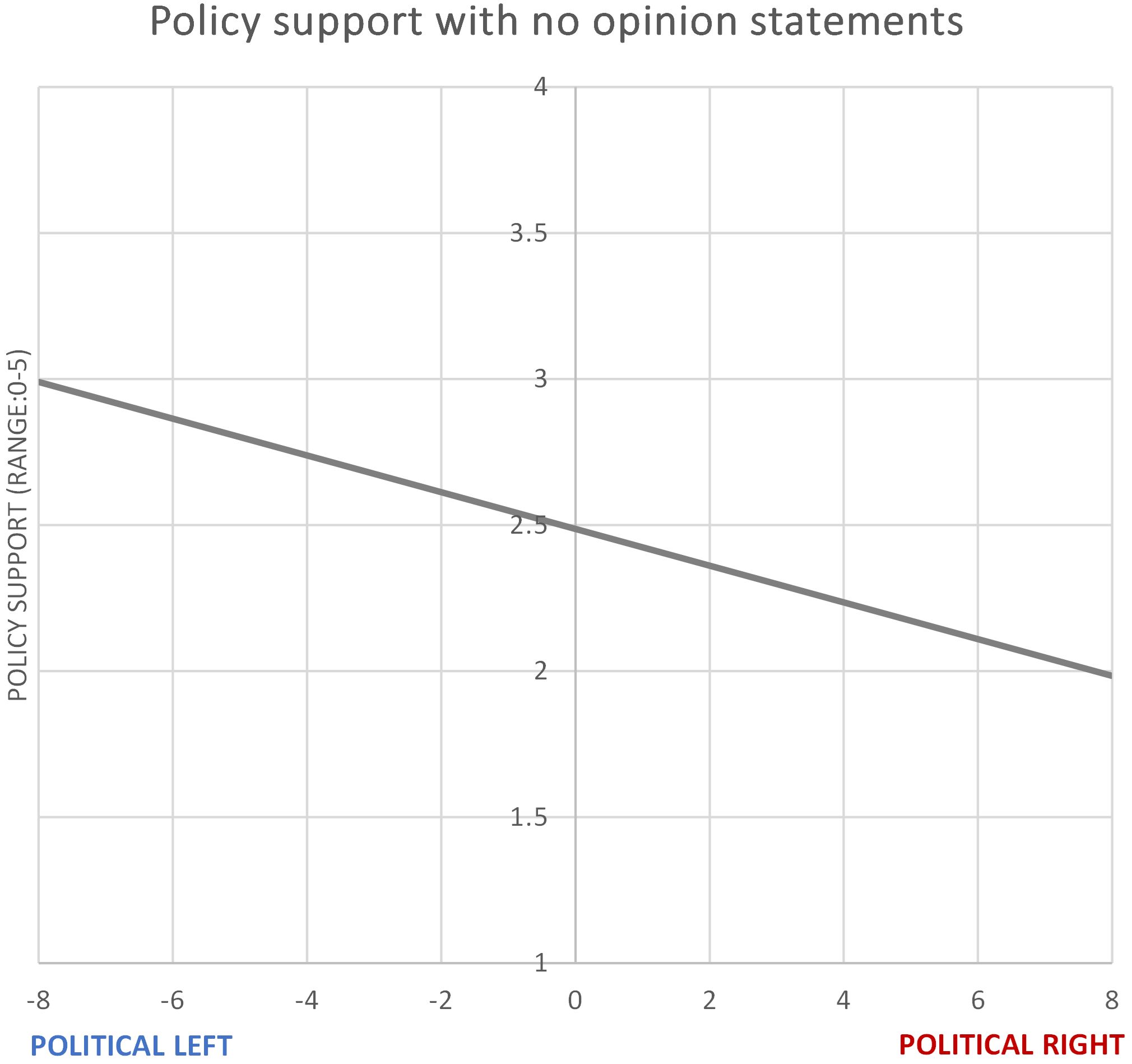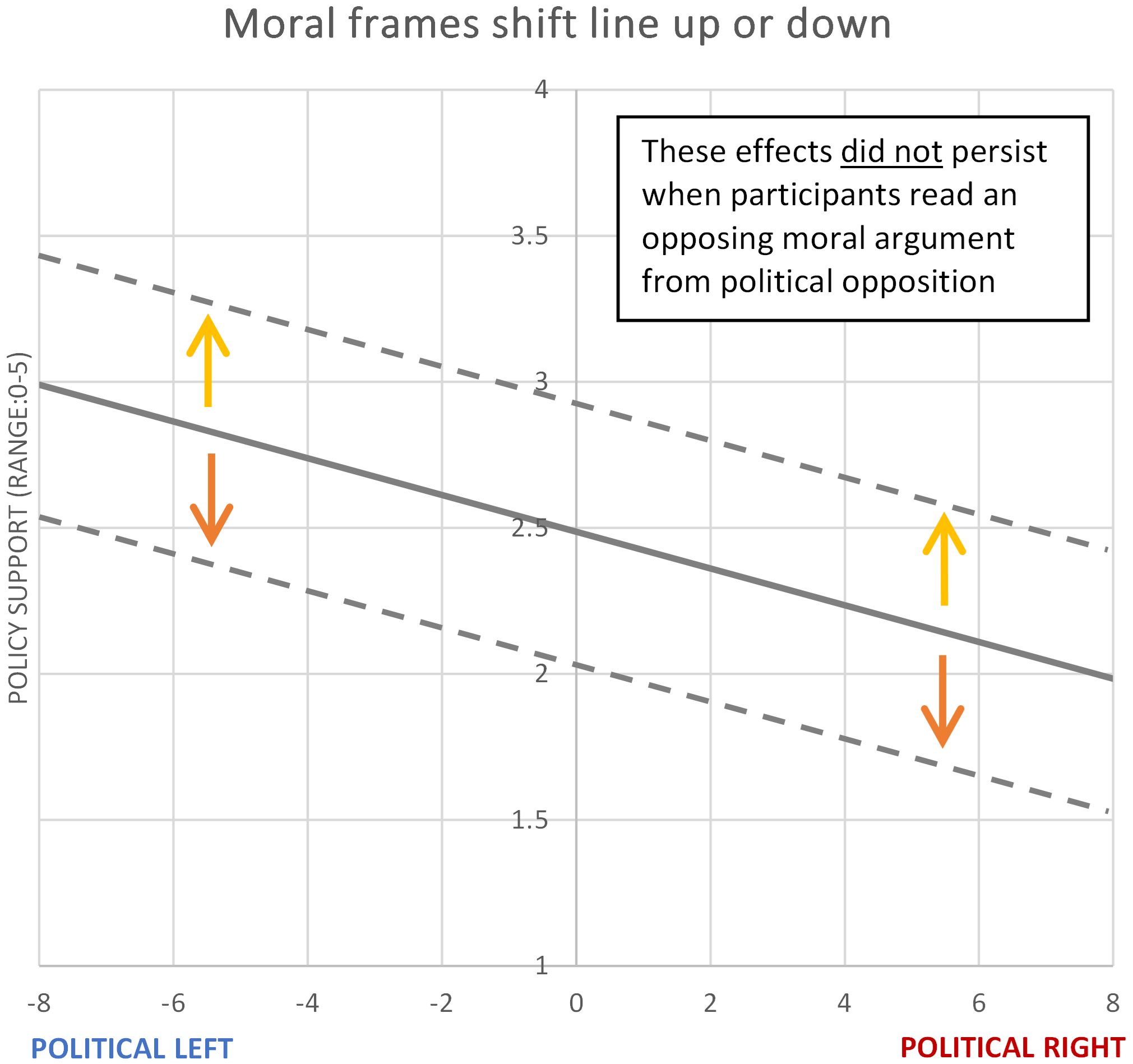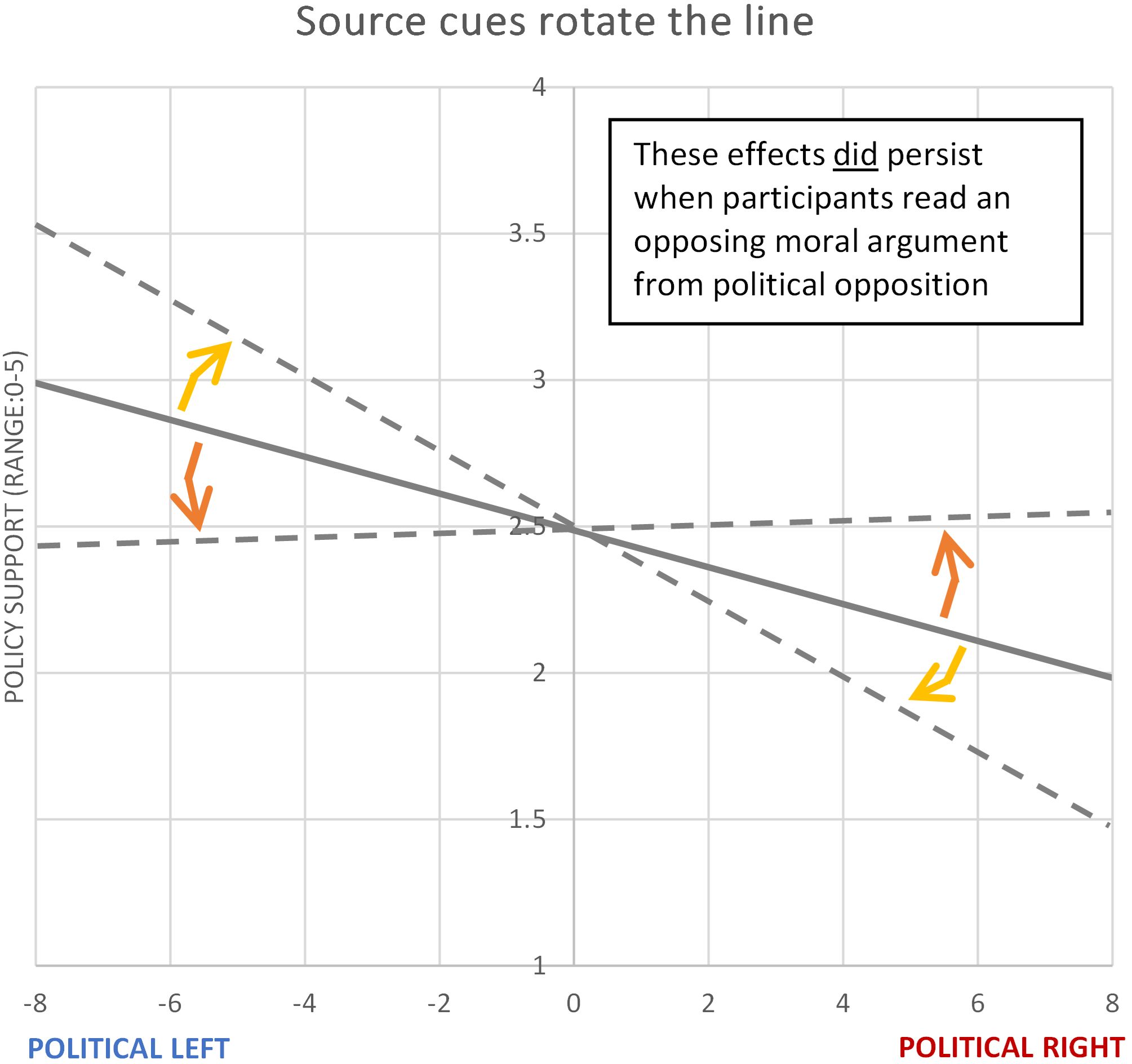When water policies are introduced, they may not be universally supported. One stakeholder group or political party may be “for” the policy and contend that the public should vote “yes.” They may argue that the policy is fair to the parties involved or that it shows loyalty to affected communities. These are moral arguments used to sway public support. An opposing stakeholder group or political party may also issue moral arguments “against” the policy. They may argue that the public should vote “no” because the policy is not fair or is disloyal to impacted communities.
In competitive policy scenarios like these, at least two factors affect public support for the policy—moral arguments and the identities of the communicators. An individual may choose to vote for or against the policy due to the content of the messages or due to their identification with the spokespersons. Understanding how each of these factors influences policy preferences is key to creating communication that is conducive to broad public support.
This publication is intended for use by water Extension agents, government officials, scientists, and other water communicators seeking to design communication that increases bipartisan support for water policy.
An Experiment on Water Messages and Messengers
A 2021 study found that moral arguments yielded changes in net water policy support levels. Across the political spectrum, the public increased their policy support when the moral message was positive and decreased their support when the moral message was negative. In contrast, the political identity of the spokespersons affected the distribution of support across the political spectrum. Depending on whether the spokesperson was a Democrat or a Republican, policy support increased on one political side and decreased on the other, effectively making the policy either more or less politically divisive.
Because policy acceptance often depends on both net policy support (a political mandate) and the minimization of political polarization, moral arguments and political spokespersons both appear important to water policy success.
How Was Policy Support Assessed?
In the 2021 study, voting age residents of Florida and Georgia (n=3,695) were presented with a fictional water policy proposal as it might appear on a voting ballot. Participants from Georgia received a similar proposal adjusted for Georgia’s geographic differences. Florida’s fictional water policy proposal was presented to participants as below:
"Florida Sample Ballot
Proposal 1
Proposal 1 would compensate farmers in the Suwannee Valley, located in north Florida, for adopting new land management practices that protect water quality and quantity. Farmer participation in the program would be completely voluntary. Farmers who choose to participate would receive payment for implementing specific farming practices that reduce the amount of water and fertilizer applied to fields. Due to the cost of the technology and the labor required to implement these practices, as well as the possibility of decreased crop yield, most farmers would not adopt these improvements without compensatory funding.
This program would help maintain groundwater levels throughout north Florida and improve water quality in the rivers and springs of the Suwannee Valley. The opportunity to participate in this particular program would be available only to farmers in the Suwannee Valley where land characteristics allow water and excess fertilizer to easily enter the groundwater and downstream rivers, lakes, and springs. Other incentive programs may be available to farmers in other parts of Florida."
After reading the proposal, participants read an opinion statement attributed to a member of either the Republican or the Democratic party, arguing either for or against the proposal. Some participants received opinion statements emphasizing the proposal’s fairness/unfairness, while others received opinion statements emphasizing the proposal’s loyalty/disloyalty. The example below emphasizes fairness/unfairness through the subject matter as well as the underlined words and phrases. (These underlines were absent during the study.) This fictional “for” opinion statement presented to Florida participants read as follows:
"Opinion: Proposal 1 fairly compensates farmers for protecting natural resources
Written by [fictional name], Policy Institute Member of the [Republican or Democratic] Party
Proposal 1 would equitably compensate farmers for investing their considerable time and money in practices that protect our state’s water supply. Florida waters are overused and polluted due to the behaviors of every person in the state. Fortunately, farmers’ willingness to bear the burden of adopting new practices can partially make up for our collective impact.
Florida farmers grow the food we eat and often do so with slim profit margins. It is only fair that we contribute our share to help farmers protect the water that grows that food and enables the quality of life that we enjoy as Florida residents. It is a matter of integrity that we justly pay back farmers for improving the resources degraded by us all.
As a member of the Policy Institute and a [Republican or Democrat], I encourage all Floridians who want to fairly compensate farmers to VOTE YES on Proposal 1."
Finally, participants read an opposing opinion statement from the other political party. This fictional “against” opinion statement was presented to Florida participants:
"Opinion: Proposal 1 unfairly pays farmers to stop damaging natural resources
Written by [fictional name], Policy Institute Member of the [Republican or Democratic] Party
Proposal 1 shows favoritism to farmers, inappropriately paying them to stop degrading the water all Floridians depend upon. Current farming practices use unnecessarily large amounts of water and pollute that water with excess fertilizer. This biased proposal uses public money to unjustly reward farmers for the damage they have caused.
These detrimental farming practices should be stopped, but not through imbalanced programs that pay farmers to protect water. Many Florida farms are large businesses that make a profit off our water. It is only fair that they bear the cost for changing practices that exploit our shared resources.
As a member of the Policy Institute and a [Republican or Democrat], I encourage all Floridians who want farmers to pay their fair share to VOTE NO on Proposal 1."
After reading each passage, participants were assessed on the likelihood that they would vote “yes,” in support of the policy. By changing combinations of “for” and “against” messages as well as the political identity of the spokesperson, researchers were able to assess the independent impact of each of these factors.
Moral Arguments and Political Spokespersons Affect Policy Support in Different Ways
Figure 1 depicts policy support across the political spectrum after participants read only the policy description and not the opinion statements. Support for the policy was greater among those who identify with the political left than those who identify with the political right. This is not surprising because the political left often prioritizes environmental objectives more than the political right (Douglas & Wildavsky, 1982; Haidt, 2012). This initial chart provides a baseline for examining the effects of the moral arguments and political source cues presented in the opinion statements.

Credit: Sadie Hundemer, UF/IFAS
Moral Arguments
Although moral arguments and political source cues were presented simultaneously to participants, the study design allows separate examination of the effects for each communication element.
When participants were exposed to a single opinion statement containing a moral argument “for” the water policy (based on either fairness or loyalty), support for the policy increased across the political spectrum. Likewise, when participants read a single opinion statement “against” the policy, support decreased across the political spectrum, as illustrated in Figure 2.

Credit: Sadie Hundemer, UF/IFAS
Then participants received a second opinion statement with the opposing moral argument (e.g., the participant received a fairness argument followed by an unfairness argument), and policy support levels returned approximately to the baseline. In other words, when competition was introduced, the effect of the first message was no longer statistically significant. In this competitive scenario, the communicator of the first message would likely see this outcome as undesirable—their message was negated. The communicator of the second message, however, would likely see this effect as positive—their message weakened the opposing position.
Political Spokespersons
When participants were exposed to a single opinion statement advocating the position of a Republican or Democrat, policy support either increased on the political left and decreased on the political right, or the opposite; it decreased on the political left and increased on the political right. Either way, the left and right moved in opposite directions. This is observed as a change in the slope of the line in Figure 3.
Importantly, the political spokesperson did not influence change in the net level of policy support. Instead, the distribution of the support changed across the political spectrum, causing the policy to become either more or less politically polarized as illustrated in Figure 3.

Credit: Sadie Hundemer, UF/IFAS
Also, when participants of either political leaning received a second opinion statement from an opposing political source (e.g., a participant who first received a Republican statement then received a Democrat statement), policy support did not return to the baseline position, unlike moral arguments. If the policy became either more or less polarized by the initial statement, that effect was not undone by receiving an opposing message from the other side. This suggests that once the topic becomes partisan, it may be difficult to undo.
The Effect of Scientific Knowledge
Study participants also completed the OWSK (Ordinary Water Science Knowledge) assessment. (See Part 1 of this series, EDIS publication #AEC786, “What Do People Know About Water Science?”) The results indicate that subject-matter knowledge was not a significant determinant of policy support. This suggests that, as the policy was presented, it was perceived less as a scientific issue than as a moral one.
How to Use This Information
You need the right message and the right messenger. Sustainable water policy often depends on a critical mass of support and bipartisanship. This study suggests that a resonating moral message may concede to the former and the identity of spokespersons may deliver the latter. Yet, the moral message and spokespersons that appeal to the political left may differ from those that appeal to the political right. It can, therefore, be necessary to evoke a range of moral messages and messengers. Each should be tested on your audiences to ensure they have the intended effect and are not counterproductive to your objectives.
Make the process collaborative. In this study, the net policy support gains, which resulted from a fairness or loyalty moral message, were lost when participants received a competing moral message emphasizing unfairness or disloyalty. Retaining the gains of positive messaging may, therefore, depend on reducing communicative competition. Among the best ways to minimize opposing messages is to include a wide range of stakeholders early in the policy process. Giving stakeholders (political and otherwise) a voice in the process increases trust, accountability, and the likelihood of policy acceptance (von Korff et al., 2012). Although stakeholder participation can foster policy support, it can also increase division in the absence of proper planning and implementation (Brett, 1996; Coglianese, 1997; Irvin & Stansbury, 2004; Priscoli, 2004; von Korff et al., 2012; Webler et al., 1995). Therefore, research on effective participatory engagement should be consulted in advance (Eaton et al., 2021; Mott Lacroix & Megdal, 2016; Rowe & Frewer, 2000; Syme & Nancarrow, 1992; Webler et al., 1995).
Beware of boomerang effects. In this study, some political spokespersons with a pro-policy message caused policy support to become more polarized and, therefore, possibly less likely to be enacted. This is called a boomerang effect because the result of the message was the reverse of the intended effect (Hart & Nisbet, 2012). Boomerang effects are best avoided through message testing that reveals how both the message and the messenger are received.
Recognize that once a policy becomes partisan, it can be difficult to undo. In this study, some combinations of political spokespersons and moral messages had the effect of increasing partisanship. This effect was not undone by an opposing moral message from the opposing side. The policy remained polarized. As described above, one of the best ways to protect against this outcome is to involve political and other stakeholders in the water management decision process. Ideally their inclusion yields a policy that both parties can get behind.
Scientific information doesn’t win the day. The public’s water science knowledge did not significantly affect their decisions. Policy is about values. (See Part 2 of this series, EDIS publication #AEC781, “Do People Believe Water Science?” for more information.)
How NOT to Use This Information
Do not rely solely on political spokespersons. There are a wide range of spokespersons who influence people when making policy decisions. On water topics, these sources may include agricultural interest groups, community groups, environmental organizations, civic leaders, and local news media. In many cases, these groups may be more effective communicators than politicians. Keep two things in mind. First, a variety of spokespersons need to be included in the water policy process to foster productive, bipartisan communication about the policy. Second, the identities of these groups convey values not unlike political spokespersons; therefore, the political right and political left may respond to communication from the groups in very different (and perhaps opposite) ways.
Summary
Moral messages and political communicators were found to have distinct effects on water policy support. While moral messages increased or decreased support across the political spectrum, political communicators moderated the degree of partisanship. These findings suggest that moral messages and the identities of communicators are both important to water policy success and should be considered in communication design.
For more information on this study, see “Building Bipartisan Support for Pro-Environmental Water Policy in a Competitive Communication Environment: The Effect of Competing Moral Frames and Political Communicators” at https://doi.org/10.1016/j.jhydrol.2023.130379 (Hundemer et al., 2023).
Acknowledgements
This material is based upon work supported by the National Science Foundation under Grant No. 2021590. Any opinions, findings, conclusions, or recommendations expressed in this material are those of the author(s) and do not necessarily reflect the views of the National Science Foundation. This project is also supported by the National Institute of Food and Agriculture, U.S. Department of Agriculture, under award number 2017-68007-26319.
References
Brett, E. A. (1996). The participatory principle in development projects: The costs and benefits of cooperation. Public Administration and Development, 16(1), 5–19. https://doi.org/10.1002/(SICI)1099-162X(199602)16:1<5::AID-PAD854>3.0.CO;2-6
Coglianese, C. (1997). Assessing consensus: The promise and performance of negotiated rulemaking. Duke Law Journal, 46(6), 1255–1349. https://doi.org/10.2307/1372989
Douglas, M., & Wildavsky, A. (1982). Risk and culture: An essay on the selection of technical and environmental dangers. University of California Press.
Eaton, W. M., Brasier, K. J., Burbach, M. E., Whitmer, W., Engle, E. W., Burnham, M., Quimby, B., Kumar Chaudhary, A., Whitley, H., Delozier, J., Fowler, L. B., Wutich, A., Bausch, J. C., Beresford, M., Hinrichs, C. C., Burkhart-Kriesel, C., Preisendanz, H. E., Williams, C., Watson, J., & Weigle, J. (2021). A conceptual framework for social, behavioral, and environmental change through stakeholder engagement in water resource management. Society & Natural Resources, 34(8), 1111–1132. https://doi.org/10.1080/08941920.2021.1936717
Haidt, J. (2012). The righteous mind: Why good people are divided by politics and religion. Random House, Inc.
Hart, P. S., & Nisbet, E. C. (2012). Boomerang effects in science communication: How motivated reasoning and identity cues amplify opinion polarization about climate mitigation policies. Communication Research, 39(6), 701–723. https://doi.org/10.1177/0093650211416646
Hundemer, S., Monroe, M. C., & Adams, D. C. (2023). Building bipartisan support for pro-environmental water policy in a competitive communication environment: The effect of competing moral frames and political communicators. Journal of Hydrology, 627(A), 1–15. https://doi.org/10.1016/j.jhydrol.2023.130379
Irvin, R. A., & Stansbury, J. (2004). Citizen participation in decision making: Is it worth the effort? Public Administration Review, 64(1), 55–65. https://doi.org/10.1111/j.1540-6210.2004.00346.x
Mott Lacroix, K. E., & Megdal, S. B. (2016). Explore, synthesize, and repeat: Unraveling complex water management issues through stakeholder engagement wheel. Water, 8(4), Article 4. https://doi.org/10.3390/w8040118
Priscoli, J. D. (2004). What is public participation in water resources management and why is it important? Water International, 29(2), 221–227. https://doi.org/10.1080/02508060408691771
Rowe, G., & Frewer, L. J. (2000). Public participation methods: a framework for evaluation. Science, Technology, & Human Values, 25(1), 3–29. https://doi.org/10.1177/016224390002500101
Syme, G. J., & Nancarrow, B. E. (1992). Predicting public involvment in urban water management and planning. Environment and Behavior, 24(6), 738–758. https://doi.org/10.1177/0013916592246003
von Korff, Y., Daniell, K., Moellenkamp, S., Bots, P., & Bijlsma, R. (2012). Implementing participatory water management: Recent advances in theory, practice, and evaluation. Ecology and Society, 17(1). https://doi.org/10.5751/ES-04733-170130
Webler, T., Kastenholz, H., & Renn, O. (1995). Public participation in impact assessment: A social learning perspective. Environmental Impact Assessment Review, 15(5), 443–463. https://doi.org/10.1016/0195-9255(95)00043-E